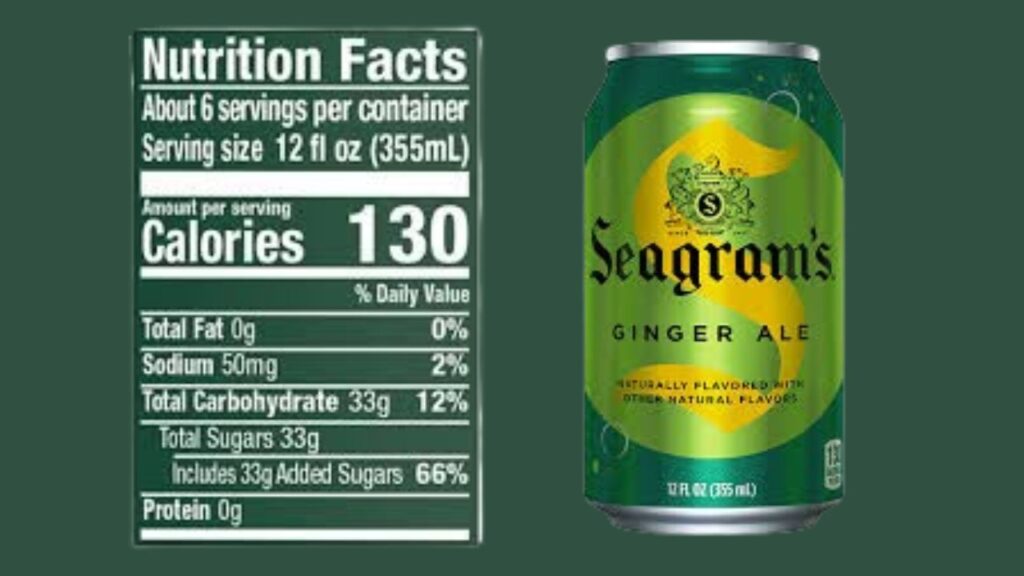Written by: Sherry Harris
Ginger ale is a classic, caffeine-free beverage loved for its refreshing taste and subtle hint of ginger spice. This article explores its key ingredients, nutritional information, daily intake recommendations, and the best alternatives for those seeking variety. By the end, you’ll have a complete understanding of why ginger ale is such a popular choice.
Table of Contents
Does Ginger Ale have Caffeine?
What Is Ginger Ale?
Ginger ale is a refreshing carbonated drink flavored with ginger, originally created in the 19th century to help with digestion and nausea. Over time, it became a popular soft drink enjoyed worldwide for its subtle spice and bubbly texture. Its initial purpose as a health tonic paved the way for its role as both a standalone beverage and a mixer for cocktails.
The main ingredients in ginger ale include carbonated water, ginger extract, sweeteners like sugar or high-fructose corn syrup, and citric acid. Some brands also add preservatives and natural flavors to enhance the taste. Premium versions often use real ginger, offering a more authentic and aromatic experience.
Does Ginger Ale have Caffeine?
Most ginger ale products are caffeine-free, making them a top choice for those avoiding stimulants. Unlike beverages like cola or energy drinks, ginger ale doesn’t rely on caffeine for flavor or appeal. This makes it a family-friendly drink suitable for all ages.
Although the majority of ginger ale brands are caffeine-free, it’s essential to verify labels for specialty products. Certain unique or craft versions may include trace amounts of caffeine due to additional ingredients. However, mainstream options like Canada Dry and Schweppes consistently remain free of caffeine.
Variants of Ginger Ale
Canada Dry
Canada Dry is one of the most recognized ginger ale brands globally, known for its mild, crisp flavor. It is completely caffeine-free, making it ideal for anyone avoiding stimulants. Canada Dry is also frequently recommended as a remedy for nausea and upset stomachs.
Schweppes
Schweppes is another trusted name offering caffeine-free ginger ale. Its balanced flavor and mild ginger notes make it a household favorite. Schweppes is also versatile, pairing well with meals or serving as a cocktail mixer.
Seagram’s
Seagram’s is a sweet and fizzy option that’s also free of caffeine. Its rich carbonation makes it particularly popular in mixed drinks. Seagram’s provides a slightly sweeter taste compared to other ginger ale brands.
Vernors
Vernors stands out for its bold, spicy ginger flavor. Despite its distinctive taste, Vernors remains caffeine-free, appealing to those looking for a stronger ginger profile without stimulants. It’s a favorite for those seeking a more robust ginger ale.
Lesser-Known Brands
Craft brands like Reed’s and Bruce Cost Ginger Ale focus on using real ginger and minimal processing. These premium options typically remain caffeine-free but may have varying flavor intensities. They cater to individuals seeking a more natural ginger ale experience.
Key Ingredients in Ginger Ale
The main ingredients that make ginger ale unique include:
- Carbonated Water: Provides the signature fizz that makes the drink refreshing.
- Ginger Extract: The core flavoring ingredient, offering its spicy and aromatic taste.
- Sweeteners: Typically sugar or high-fructose corn syrup, adding sweetness to balance the ginger.
- Citric Acid: Enhances the drink’s tangy notes and acts as a preservative.
- Natural or Artificial Flavors: Enhance the overall profile of ginger ale, depending on the brand.

Does Ginger Ale have Caffeine?
Nutritional Information Ginger Ale
Ginger ale is generally considered a low-calorie beverage but can vary depending on the brand and type. The diet versions are lower in calories due to artificial sweeteners. Below is a table summarizing the typical nutritional information per 12-ounce serving:
| Nutrition Facts | Amount per Serving |
|---|---|
| Calories | 120-140 kcal |
| Total Sugars | 30-35 g |
| Sodium | 35-50 mg |
| Carbohydrates | 32-36 g |
Do You Know?
👉 Does Bang Energy Drink Have Caffeine?
Why People Avoid Caffeine
Health Reasons
Many people choose caffeine-free drinks like ginger ale to avoid the side effects of caffeine, such as insomnia, jitters, or increased heart rate. It’s a safer choice for individuals with caffeine sensitivities or specific health concerns. Caffeine-free beverages are also preferred by pregnant individuals or those managing anxiety.
Dietary Preferences
Certain diets, such as those followed during pregnancy or by children, recommend avoiding caffeine. Ginger ale serves as a flavorful alternative for those maintaining a stimulant-free lifestyle. Its gentle ingredients make it a universally accepted beverage.
Alternatives to Ginger Ale
If you’re looking for caffeine-free beverages with similar characteristics, here are five alternatives to ginger ale, explained in detail:
Root Beer
Root beer is a sweet and bubbly drink made with extracts like sassafras and vanilla. Like ginger ale, it is caffeine-free, making it suitable for all age groups. Its creamy, rich flavor is a perfect match for desserts or as a standalone treat.
Lemon Soda
Drinks like Sprite or 7UP are excellent alternatives to ginger ale for their crisp and citrusy flavor. These sodas are also caffeine-free and widely available. They are versatile as standalone beverages or mixers in cocktails.
Club Soda
For a healthier alternative, club soda with a splash of lime mimics the fizzy nature of ginger ale. It’s calorie-free and caffeine-free, appealing to health-conscious individuals. Adding fresh herbs like mint can enhance its refreshing taste.
Herbal Iced Tea
Iced teas made from chamomile, hibiscus, or peppermint are soothing, naturally caffeine-free options. They provide a calming and flavorful experience similar to ginger ale but without added sugar or carbonation.
Cream Soda
Cream soda is a sweet and vanilla-flavored option that offers a smooth texture. Like ginger ale, it is caffeine-free and pairs well with meals or desserts. Its sweetness makes it a hit among children and adults alike.
| Alternatives | Caffeine Content |
|---|---|
| Root Beer | 0 mg |
| Lemon-Lime Soda | 0 mg |
| Club Soda with Lime | 0 mg |
| Herbal Iced Tea | 0 mg |
| Cream Soda | 0 mg |
Do You Know?
👉 How Much Caffeine in Red Bull?
👉 Does Alani Energy Drink Have Caffeine?
Benefits of Ginger Ale
Relief from Nausea
Ginger ale is often recommended for its ability to ease nausea and motion sickness. Ginger contains compounds like gingerol that provide natural anti-nausea effects. This makes it a favorite remedy for travelers or those recovering from illness.
Digestive Health
The ginger in ginger ale can relax stomach muscles and promote the release of digestive enzymes. This helps alleviate mild digestive discomfort and bloating. Drinking ginger ale after a meal can provide a soothing effect.
Refreshing Taste
The fizzy, light taste of ginger ale, combined with its hint of ginger spice, makes it a refreshing choice. It’s especially popular as a summer drink or as a complement to various cocktails and mocktails.
Ginger Ale vs. Ginger Beer
Key Differences
Though both drinks share a ginger base, ginger ale is sweet and lightly carbonated, while ginger beer is stronger and fermented. Ginger beer’s bold flavor makes it less sweet than ginger ale. These differences cater to diverse taste preferences.
Caffeine Content
Both ginger ale and ginger beer are typically caffeine-free. However, always check product labels for confirmation, especially with craft or specialty options.
Homemade Ginger Ale
Easy Recipes
Homemade ginger ale is simple to prepare using fresh ginger, sugar, water, and soda water. This allows you to enjoy a fresher and more natural beverage without artificial additives.
Controlling Additives
By making your own ginger ale, you have complete control over the sugar content and can avoid preservatives. It’s a healthier and more personalized alternative to store-bought varieties.
Who Should Drink Ginger Ale?
Because ginger ale is caffeine-free, it’s a safe beverage for people of all ages, from children to seniors. Its mild flavor and health benefits make it a universally appealing option.
While generally safe, individuals managing sugar intake, such as those with diabetes, should opt for diet versions of ginger ale or consume it in moderation.
Daily Intake of Ginger Ale
Moderation is key when consuming ginger ale due to its sugar content. For most adults, a 12-ounce serving per day is reasonable, especially if complemented by a balanced diet. Choosing diet versions or natural alternatives can help reduce calorie intake without compromising on flavor.
For children and individuals managing conditions like diabetes, limiting ginger ale to occasional consumption is advisable. Always check nutritional labels to ensure the drink fits into your daily dietary needs. Pairing it with meals can help slow the absorption of sugar, promoting better digestion.
Conclusion
Ginger ale is a timeless beverage known for its versatility, mild sweetness, and caffeine-free nature. Whether consumed for its digestive benefits or enjoyed as a refreshing drink, it remains a popular choice for all age groups. Its availability in both regular and diet versions ensures there’s an option for everyone.
By exploring its ingredients, nutritional profile, and caffeine-free alternatives, you can make informed decisions about incorporating it into your lifestyle. Remember, while ginger ale can be a delightful treat, mindful consumption ensures you enjoy its benefits without overindulging.
Frequently Asked Question
Q. Is Ginger Ale Healthy?
While ginger ale is caffeine-free, it often contains high amounts of sugar, which can contribute to weight gain and other health issues. Opting for diet versions or consuming it in moderation can mitigate these concerns.
Q. Can Ginger Ale Help with Nausea?
Ginger ale is often used as a home remedy for nausea because ginger is known for its anti-nausea properties. However, the amount of actual ginger in commercial ginger ale varies by brand and is often minimal. For better results, drinking beverages made with real ginger or ginger tea may provide more effective relief for nausea.
Q. Is Ginger Ale Healthy to Drink Regularly?
Drinking ginger ale in moderation can be a part of a balanced diet, but regular consumption should be monitored due to its sugar content. Opting for diet versions or brands with natural sweeteners can reduce calorie intake. While ginger ale offers a refreshing and caffeine-free alternative to other sodas, it’s not a significant source of nutrients and should not replace water or other healthier beverages.
Q. Can Ginger Ale Be Used as a Mixer in Cocktails?
Absolutely! Ginger ale is a popular mixer for cocktails due to its light and fizzy texture, complemented by its mildly sweet and gingery flavor. It pairs well with spirits like whiskey, vodka, and rum, adding a refreshing twist to classic cocktails. Using ginger ale in mocktails is also a great way to create non-alcoholic, flavorful drinks for any occasion.
Q. What Is the Difference Between Ginger Ale and Ginger Beer?
While both ginger ale and ginger beer share ginger as a primary ingredient, they differ significantly. Ginger ale is a sweetened, carbonated soft drink with a milder ginger flavor, whereas ginger beer is brewed and fermented, offering a spicier and more robust taste. Additionally, some ginger beers may contain alcohol, while ginger ale is always non-alcoholic.
Does Ginger Ale have Caffeine?

